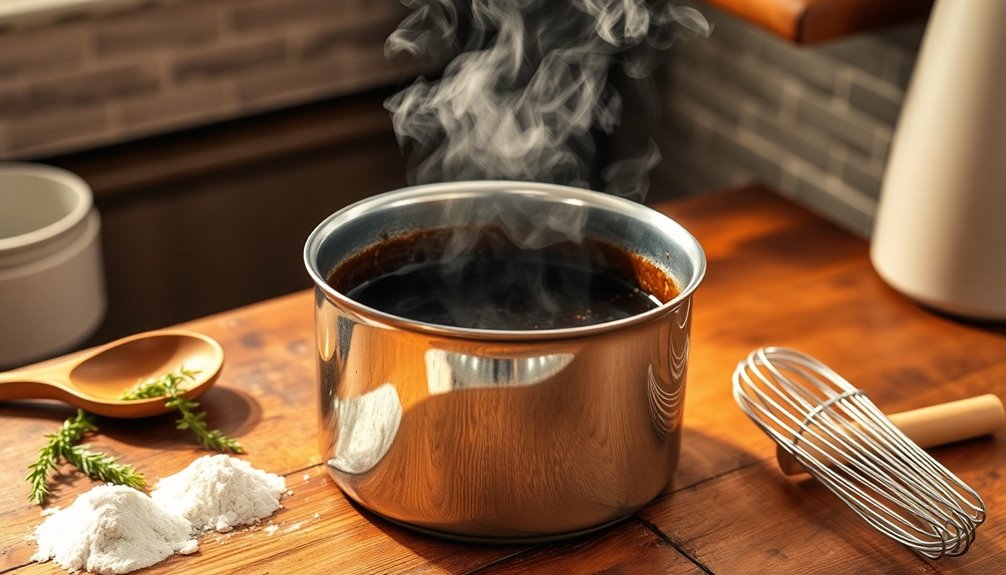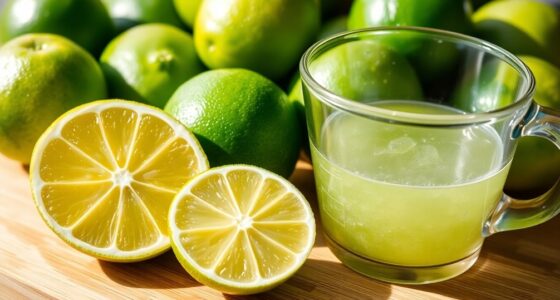To make gravy from pot roast juice, start by straining the drippings to remove solids. Pour the liquid into a skillet and whisk in an equal amount of flour, adding salt and pepper to taste. Bring to a boil while stirring to thicken. For enhanced flavor, consider adding Worcestershire sauce or sautéed onions and mushrooms. If your gravy's too thin, mix cornstarch with cold water and whisk it in to thicken. Stick around for more tips on perfecting your gravy!
Key Takeaways
- Strain pot roast drippings through a fine mesh sieve to remove solids for a smooth gravy base.
- Add an equal amount of flour to the drippings, season, and stir to prevent lumps.
- Bring the mixture to a boil while stirring continuously until it thickens to the desired consistency.
- Enhance flavor by adding Worcestershire sauce or sautéed onions and mushrooms before thickening.
- Adjust seasoning and serve hot gravy over pot roast or with mashed potatoes for a delicious meal.

Making gravy from pot roast juice is a simple and rewarding way to enhance your meal. When you finish cooking your pot roast, you'll notice those delicious drippings left in the pot. Instead of letting them go to waste, you can transform them into a rich and flavorful gravy. It's all about using those pot roast drippings to create a smooth gravy base that complements your dish perfectly.
Start by straining the pot roast drippings through a fine mesh sieve. This step is crucial because it removes any solids, ensuring you have a silky smooth gravy base. Once you've done that, grab a skillet and pour in the strained drippings. This is where you'll begin to make your gravy. To thicken it up, you'll need to add an equal amount of flour—typically about ¼ cup. Sprinkle the flour into the drippings and season with salt and pepper to taste. Stir this mixture well to combine, so you don't end up with lumps.
Next, it's time to bring the mixture to a boil. As you do this, keep stirring continuously. This action is vital because it prevents lumps from forming and ensures the flour incorporates smoothly into the drippings. As the mixture heats up, you'll notice it beginning to thicken. Keep stirring until it reaches your desired consistency. If you prefer a richer flavor in your gravy, consider adding a dash of Worcestershire sauce at this stage. This ingredient can elevate the taste and add depth to your gravy.
For an even heartier option, you might want to sauté some onions and mushrooms beforehand and mix those in before thickening.
However, if you find that your gravy is too thin and not thick enough for your liking, you can easily remedy that. Create a cornstarch slurry by mixing a tablespoon of cornstarch with a couple of tablespoons of cold water. Whisk this mixture until it's smooth, then slowly whisk it into your simmering gravy. Keep the gravy on the heat, and it will thicken up nicely. This method is a great backup plan if the flour didn't achieve the thickness you wanted.
Once your gravy is the perfect consistency, give it one final taste. It's important to adjust the seasoning if necessary. Sometimes a little more salt or pepper can make all the difference.
Serve your homemade gravy hot over your pot roast or alongside mashed potatoes. You'll find that it enhances the flavors of your meal and brings everything together beautifully. With just a few simple steps, you've turned pot roast drippings into a delicious gravy that elevates your dining experience. So go ahead, enjoy your meal, and relish in the fact that you've made something truly special from what would have been leftovers!
Frequently Asked Questions
How Do You Thicken Pot Roast Juice for Gravy?
To thicken pot roast juice for gravy, you've got a couple of options.
For a cornstarch slurry, mix equal parts cornstarch and cold water, about 2 tablespoons each per cup of liquid.
If you prefer a flour-based gravy, cook flour in drippings to create a roux, then whisk in the juice gradually.
Simmer for a few minutes, stirring constantly, and adjust the thickness by adding more slurry or liquid as needed. Once you achieve the desired consistency, it’s time to add your flavorings, such as herbs and spices, to elevate the dish. For those interested in experimenting with unconventional beverages, learning how to prepare hippie juice is a fun and nutritious option that combines fresh fruits and vegetables for a refreshing taste. Enjoy your meal and remember to share your culinary creations with friends!
How to Make Gravy From Crock Pot Liquid?
To make gravy from crock pot liquid, start by straining the liquid to remove any solids.
In a skillet, combine the strained liquid with flour or cornstarch to create a roux, cooking it for about a minute.
Gradually whisk in broth or water, bringing it to a boil while stirring until it thickens.
Finally, season it to taste and enjoy your delicious gravy over your favorite dish!
How to Make Gravy From the Roast Juice?
Ever wondered how to turn those delicious drippings into gravy?
Start by straining the roast juice through a fine mesh sieve to catch any solids.
In a skillet, mix the strained drippings with flour, using about ¼ cup for every 3 cups of liquid.
Season with salt and pepper, then bring it to a boil while stirring.
For a thicker consistency, add a cornstarch slurry.
Adjust the seasoning, and enjoy your homemade gravy!
How Do You Turn Liquid Into Gravy?
To turn liquid into gravy, start by straining it to remove any solids, creating a smooth base.
Then, make a roux by melting butter and whisking in an equal amount of flour until it's golden.
Gradually add the strained liquid while stirring to avoid lumps.
If you want it thicker, mix cornstarch with cold water and whisk it in.
Finally, season to taste and let it simmer for rich flavor.
Conclusion
You've successfully transformed your pot roast juice into a delicious, delectable gravy! With just a few simple steps, you've created a savory sauce that enhances every meal. Don't forget, this flavorful finish can elevate everything from mashed potatoes to meatloaf. So, savor your success and serve it up with pride! Remember, with a little creativity and care, you can make mealtime magical. Enjoy your tasty triumph and keep experimenting with those delightful drippings!
Cindy thoroughly researches juicing trends, techniques, and recipes to provide readers with practical advice and inspiration. Her writing style is accessible, engaging, and designed to make complex concepts easy to understand. Cindy’s dedication to promoting the advantages of juicing shines through her work, empowering readers to make positive changes in their lives through the simple act of juicing.











